_____PAID MEDIA GUIDE FOR CYBERSECURITY
Reboot Insight Report: Winning Paid Media in Cybersecurity



This whitepaper is based on an in-depth analysis of paid search strategies, ad copy, conversion tactics, and digital presence across leading cybersecurity and password management brands. We evaluated over 180 individual paid search ads and reviewed associated landing pages, trust signals, pricing visibility, and calls-to-action.
Our goal was to uncover recurring patterns, performance gaps, and standout approaches in how cybersecurity vendors engage their target audiences as well as provide a comprehensive overview of how paid media can help brands achieve success in the cybersecurity space.
Table of Contents
1. Understanding the Cybersecurity Buyer 2. Why Paid Media is Essential for Cybersecurity Brands 3. Where Cybersecurity Buyers Engage 4. CRM Integration: A Critical Factor for Success 5. Smart Ad Copy Analysis: Key Findings from Industry Leaders 6. Top 10 Takeaways From Our Findings 7. Feature Focus in Paid Search Ads: Key Emphases and Gaps 8. Why Reboot Is The Right Paid Media Partner For Cybersecurity Businesses 9. What Does This Mean for You?Understanding the Cybersecurity Buyer
Cybersecurity buyers are known for their scepticism and are typically resistant to aggressive sales tactics. Their primary concerns revolve around compliance, data security, and demonstrable effectiveness, rather than flashy marketing or bold claims. Our research across leading players in the space showed that messaging rooted in transparency and credibility was consistently preferred over “hard-sell” or overly promotional approaches.
For brands in this space, success hinges on building a strong reputation, leveraging trust signals, and establishing social proof to instil confidence in potential buyers.
A well-crafted paid media strategy plays a crucial role in reinforcing these trust elements and guiding prospects through their decision-making process.

The Cybersecurity Buyer’s Journey
Cybersecurity purchase cycles are often long and complex, making it essential for businesses to engage customers effectively at every stage of the journey. Success hinges on understanding evolving needs and guiding prospects with the right messaging and support throughout the decision-making process.

1. Awareness Stage
At this stage, buyers are conducting research on threats, compliance requirements, and best practices. Their search behaviour tends to be educational, often including queries such as “What is Zero Trust security?” or “How to prevent phishing attacks.”
💡Reboot’s tip:
Target early-stage queries with educational ads that speak to broader industry concerns, such as compliance changes, emerging threats, or evolving best practices. Instead of selling the product outright, position your brand as a helpful guide with downloadable resources, webinars, or blog content that builds trust and keeps your brand top of mind as buyers move downstream.
2. Consideration Stage
Buyers now understand their challenges and begin exploring potential solutions. They actively research vendors, compare features, and start shortlisting providers. Strong performing copy paired with competitive positioning is key here, yet only a small percentage of brands use comparison-based messaging.
💡Reboot’s tip:
Use comparison-based ad copy that clearly positions your brand against competitors. Phrases like “Compare Us to [Brand]” or “Why Top CISOs Choose Us Over X” can help buyers navigate vendor selection and increase CTRs. Including side-by-side feature breakdowns or third-party endorsements on landing pages also reinforces credibility.
3. Evaluation Stage
With a refined list of options, buyers assess vendors based on security capabilities, pricing, compliance certifications, and long-term value. Most providers leaned heavily on discount-based messaging at this stage, but only 4% connected pricing to value overall delivered.
💡Reboot’s tip:
Pair pricing mentions with a clear articulation of value, whether it's enterprise features, data sovereignty, 24/7 support, or compliance alignment. Use case studies or calculators to show ROI beyond cost, helping buyers justify their choice internally.
4. Decision Stage
Buyers are now ready to make a purchase. At this phase, they seek validation through peer reviews, compliance documentation, and proof of ROI. While many brands reference social proof, fewer than 5% of ads provided clear or contextual evidence to support their claims.
💡Reboot’s tip:
Layer in rich social proof like customer quotes, G2 ratings, compliance badges, or user count with contextual headlines such as “Trusted by 20,000 IT Pros.” Tailor copy to the vertical or persona, for example, “Why Healthcare CISOs Trust Us for HIPAA Compliance,” to build reassurance at the final step.
Why Paid Media is Essential for Cybersecurity Brands
In addition to long sales cycles, the cybersecurity industry is highly reactive, demand can spike suddenly due to emerging threats, regulatory shifts, or high-profile breaches. A strategic, flexible paid media plan is essential to stay ahead of these shifts and capitalise on moments when urgency drives buyer action.
Paid media enables cybersecurity brands to:
- Scale campaigns quickly in response to market demand
- Increase brand visibility at key decision-making moments
- Position themselves as thought leaders during critical events
A consistent paid media strategy may increase the chances of outperforming peers in visibility and engagement when market demand surges
How Paid Media Drives Cybersecurity Success
Be Present When Buyers Are Searching
Appearing in top search results is critical. Ads on Google and Bing provide visibility, ensuring brands capture high-intent traffic early.
Target the Right Decision-Makers
LinkedIn Ads allow targeting of specific personas such as CISOs, IT managers, and compliance officers. Our analysis revealed that few companies (just 20%) currently use persona-specific ad copy, revealing room for improvement.
Educate & Nurture Leads
Paid ads can drive traffic to whitepapers and webinars, helping brands build trust and be seen as a trusted leader in the industry.
Leverage Social Proof
Campaigns that amplified customer reviews, certifications, and media mentions performed better. Strong examples include adding awards and client testimonials strategically placed in ad copy and on the website.
Compete Against Larger Rivals
Smaller firms can gain market share through refined messaging and smart placement of ads. Our analysis found that several smaller players outperformed competitors in relevance with comparison or emotion-driven messaging.
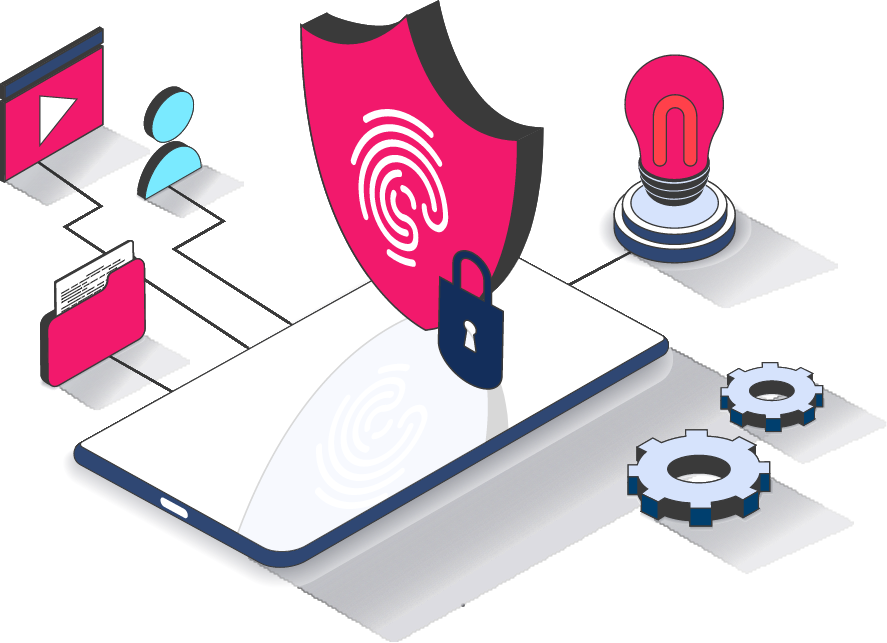
Where Cybersecurity Buyers Engage
Cybersecurity buyers are actively researching across paid media channels like LinkedIn, Google Search, and YouTube. Decision-makers engage with thought leadership and analyst content on LinkedIn and industry publications, while high-intent searches on Google like “Best ransomware protection” signal strong buying intent. YouTube and webinars also play a growing role in influencing purchase decisions, yet remain underutilised, presenting a clear opportunity for brands to stand out.

LinkedIn & Industry Publications – Decision-makers follow thought leaders and engage with whitepapers. High-performing brands promoted analyst reports and sponsored content.

Google Search – Buyers use specific queries like “Best ransomware protection.” Brands bidding on high-intent keywords are able to more effectively harvest conversions from customers when running paid search ads.

YouTube & Webinars – Demos and expert panels influenced purchasing decisions. Few brands leveraged YouTube, representing growth opportunity.
The Importance of Effective CRO Tactics When Running PPC Campaigns
In high-stakes, high-cost environments where CPC rates vary widely, from as little as £0.50 to over £30, Conversion Rate Optimisation (CRO) is critical to maximising the value of your paid media investment. This section explores proven CRO tactics and emerging trends designed to turn clicks into meaningful, measurable conversions.
CRO Trends From Our Research:
Ensure message consistency between ads and landing pages: Continuity between ad copy and landing page content helps build trust and reduce bounce rates by meeting user expectations.
Build trust through social proof and reassurance cues: Testimonials, customer logos, certifications, and transparent privacy statements all contribute to greater credibility - especially vital in a risk-averse category.
Simplify and streamline forms: Forms with two or three fields consistently outperformed longer formats. Reducing friction is key, particularly when targeting time-pressured decision-makers.
Use transparent pricing to reduce drop-off: Clearly communicating pricing upfront helps set expectations and avoid friction later in the journey, particularly in a space often associated with hidden costs.
Offer free trials or demos to drive engagement: Over 90% of high-performing sites offered free access to the product, helping prospects self-qualify and improving lead quality.
Leverage remarketing to nurture and convert: Tailored messaging based on user behaviour helps guide prospects back into the funnel and convert previously missed opportunities.
CRM Integration: A Critical Factor for Success
CRM integration ensures marketing and sales alignment. Brands using CRM-linked optimisation have better insight into LTV, close rates, and cost-per-sale, enabling smarter investment.

Key Benefits:
Track leads and attribute ROI: Know which channels and tactics drive real pipeline, not just clicks.
Personalised content journeys: Serve tailored content based on behaviour to move buyers through the funnel.
Align with sales for faster follow-up: Ensure hot leads are routed quickly with the right context.
Use customer data to inform strategy: Connect CRM and campaign data to optimise for lead quality and LTV.
Retarget with account-level precision: Re-engage high-value accounts with messaging that matches their stage and intent.
Smart Ad Copy Analysis: Key Findings from Industry Leaders

To assess how cybersecurity brands are positioning themselves in the market, we analysed over 180 paid search ads across leading industry players. This included both branded and non-branded keyword campaigns, focusing on ad copy, structure, extensions, and calls to action. We evaluated the messaging themes, tone, and value propositions used, as well as the presence (or absence) of competitive differentiation.
Our analysis was conducted across multiple timeframes and geographies to identify consistent patterns and trends in paid media strategy. This helped us understand how brands respond to spikes in demand, position themselves during critical moments, and leverage paid search to drive visibility and performance. Here's what we found:
Over 71% of ads relied on generic terms like “secure,” “private,” or “trusted,” but failed to explain how their offering was meaningfully different, making the ads easy to ignore in a crowded space.
31% of ads promoted discounts, yet only 4% connected those offers to the value delivered (e.g., features unlocked, long-term savings, or product quality), resulting in shallow messaging that lacked persuasive power.
42% included trust signals such as certifications or user counts, but fewer than 5% gave them meaningful context, like explaining what the certification means or where the data came from, reducing the impact of those credibility markers.
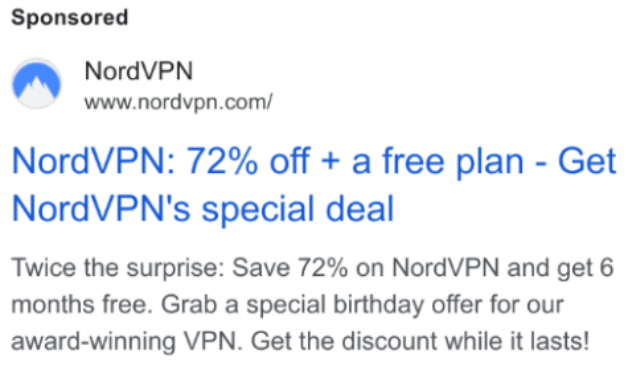
*Sample ad from NordVPN showcasing discounts
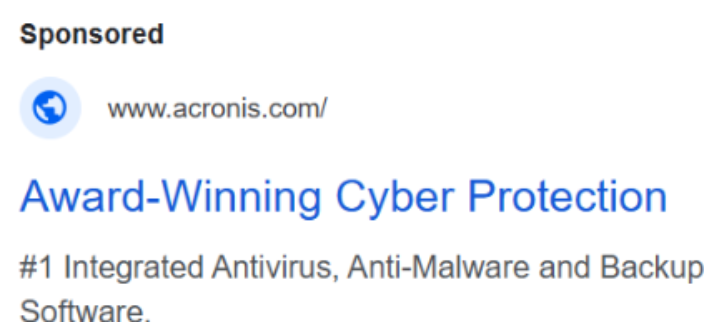
*Sample Acronis ad showcasing trust signals
Only 22% of ads used emotional hooks, despite cybersecurity being an inherently emotional category. Brands missed opportunities to tap into fear of breaches, peace of mind, or professional responsibility.
Over 56% of ads reused nearly identical copy across variants and campaigns. This limited creative testing and led to fatigue, particularly in competitive search environments where differentiation is critical.
Just 20% of ads were tailored to specific personas such as CISOs, IT managers, or SMBs, leading to messaging that felt generic rather than personally relevant to decision-makers.
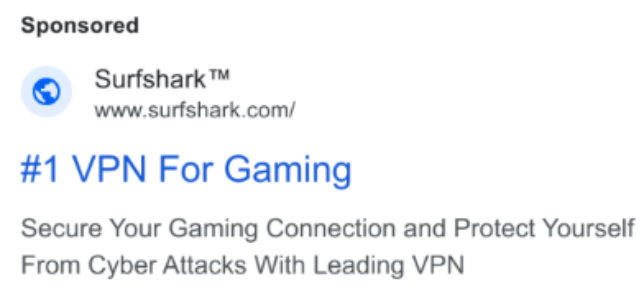
*Persona targeted sample ad from SurfShark
Over 56% of ads reused nearly identical copy across variants and campaigns. This limited creative testing and led to fatigue, particularly in competitive search environments where differentiation is critical.
Only 7% used competitive or comparison-based messaging, such as “Switch from X” or “See how we stack up,” even though these tactics are highly effective for grabbing attention and converting mid-funnel prospects.
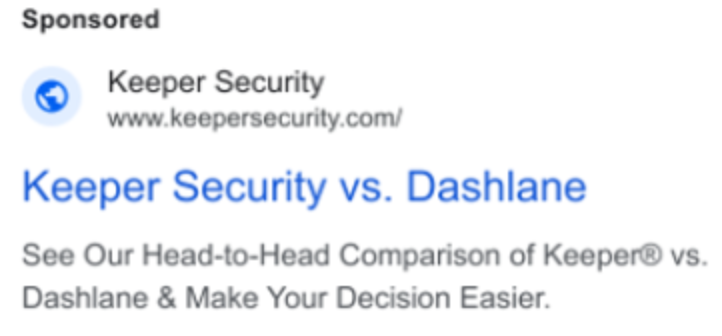
*Comparison based messaging sample ad from
Keeper Security
80% of brands bid on their own brand terms, but in 60% of those cases, no competitors were actually bidding, indicating a potential overspend on low-risk traffic that could be reallocated to more incremental growth areas.
0% of ads used dynamic countdown timers. Industry-wide, fewer than 1 in 5 brands use dynamic countdown timers, and none of the cybersecurity companies in this review deployed them. This represents an untapped opportunity to introduce urgency in ad copy through time-sensitive messaging.
Top 10 Takeaways From Our Findings
Differentiate with Proof, Not Platitudes
Replace generic buzzwords like secure, private, or trusted with specific feature-led proof points. Examples:
- “Zero-knowledge encryption with AES-256.”
- “SOC 2 Type II certified data centres.”
Tie Discounts to Tangible Value
Frame promotions around the value unlocked, not just percentages. Example:
- “Save 50% on the 2-Year Plan, get unlimited device protection and priority support.”
Give Trust Signals Teeth
Add meaningful context to trust badges. Instead of “Trusted by 5M+ users,” say:
- “Trusted by 5M+ users, including Fortune 500 teams and top-rated on TrustPilot.”
Tap Into Emotions, Cybersecurity Is Emotional
Build emotional hooks into headlines and descriptions. Examples:
- “Sleep better knowing your team’s data is secure.”
- “Don’t be the next breach headline.”
Segment Messaging by Persona
Tailor copy for key decision-makers like CISOs, IT managers, and SMB owners. Example:
- “CISO-ready compliance for zero-stress audits.”
- “Built for lean IT teams, no onboarding required.”
Scale Creative Testing, Ditch the Copy Clones
Build structured A/B/C tests with varied emotional tones, feature emphasis, and urgency angles. Refresh regularly.
Go on Offence with Competitive Messaging
Try ad variations that target switchers or create contrast:
- “Tired of Nord? Try real privacy.”
- “Why IT teams are leaving Dashlane for [Your Brand].”
Re-evaluate Brand Bidding Spend
Audit brand-term spend regularly. If no competitors are bidding, reduce budget or reallocate toward generic or conquesting campaigns.
Add Countdown Timers for FOMO
Use dynamic countdowns in ad extensions or headline copy. For example:
- “Offer ends in 2 days.”
Introduce Use-Case Driven Messaging
Highlight specific scenarios or pain points your product solves. For example:
- “Protect remote employees with one-click VPN access.”
- “Secure client data during M&A activity.”
Feature Focus in Paid Search Ads: Key Emphases and Gaps
Our review of ad copy across leading cybersecurity and password management brands shows a clear pattern in how features are prioritised. Most brands are leaning heavily on core functionality to drive clicks, but there’s untapped potential in highlighting more specialised capabilities.
Most Commonly Highlighted
Features:
The majority of brands emphasise foundational tools like VPN and password generation. These features are well understood by consumers and serve as strong entry points for user acquisition.

VPN - mentioned in 30% of ads; foundational and often treated as a default offering.
Cross-Platform Functionality - mentioned in 9% of ads; underscores convenience and flexibility.
Password Generator - appears in 3% of ads; helpful, user-friendly, and conversion-friendly.
Secure Sharing - appears in 2% of ads; niche use-case but valuable for collaborative needs.
Two-Factor Authentication (2FA) - featured in less than 1% of ads; signals trust and security.
Dark Web Monitoring - less than 1%; suggests an opportunity to lean into proactive security.
Strategic Implications:
While the focus on tried-and-tested features makes sense, it creates a sea of sameness in the SERPs. Brands that push more unique or specialised features could break through that clutter.

There’s a clear opportunity to differentiate through lesser-mentioned features like Secure Sharing and Dark Web Monitoring.

A more diverse feature mix in ad copy could strengthen paid search strategies by improving ad relevance and engagement, signalling broader product depth, and appealing to both generalist and niche user segments.

Highlighting these more niche capabilities may resonate with users who are further down the funnel or seeking added value.
Why Reboot Is The Right Paid Media Partner For Cybersecurity Businesses
At Reboot, we don’t just run ads, we engineer performance-led growth. Our experts have deep experience running campaigns that capture high-intent users and leverage strategies focused on ROI, not just clicks.
How We Help Cybersecurity
Brands Win:
We combat creative fatigue with structured testing: Our campaigns include ongoing tests across emotional, persona-driven, and competitor-focused messaging to keep creative fresh and impactful.
We refocus brand spend for greater impact: By reallocating budget from low-value brand terms to high-intent keywords and competitive conquesting, we drive more incremental growth and increased impression share.
We connect on an emotional level: We go beyond technical specs, writing ad copy that speaks to business outcomes and the real-world concerns of cybersecurity buyers.
We optimise landing pages for conversion: From trust signals to simplified forms, we refine the full user journey to maximise lead quality.
We track real impact, not just clicks: Our team integrates CRM and first-party data to attribute revenue, lead quality, and LTV so you see true business results.
We uncover hidden opportunities through research: Our competitive analysis and keyword gap audits help identify whitespace your competitors haven’t touched.
What Does This Mean for You?
Your investment is strategically optimised to drive meaningful growth, measurable returns, and long-term value. You get a team that moves fast, thinks deeply, and acts with precision, adapting to market shifts, outmanoeuvring competitors, and continuously pushing for better performance across every channel.
Ready to turn paid media into a true growth engine? Get in touch to learn more about our paid media agency, how we work, and explore client success stories. Whether you're looking for sharper strategy, stronger results, or a partner who truly understands performance, we're here to help you scale with confidence.

“Having worked with leading cybersecurity brands, we’ve seen firsthand how Paid Media is a crucial part of their marketing mix. In an industry where trust, credibility, and differentiation are paramount, targeted digital campaigns help drive awareness, generate high-intent leads, and position brands as industry leaders. Given the competitive landscape, leveraging Paid Media effectively ensures cybersecurity companies stay ahead by reaching the right audiences with the right message at the right time.”
Kurt Geater
Paid Media Specialist

Our clients are our biggest advocates

